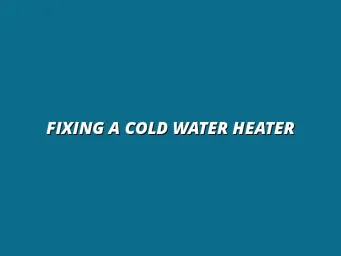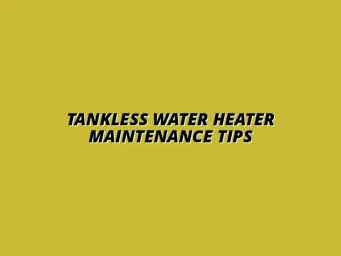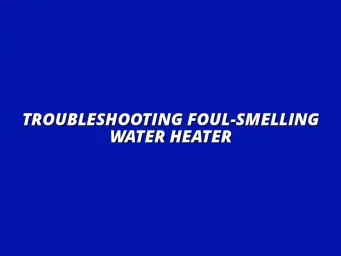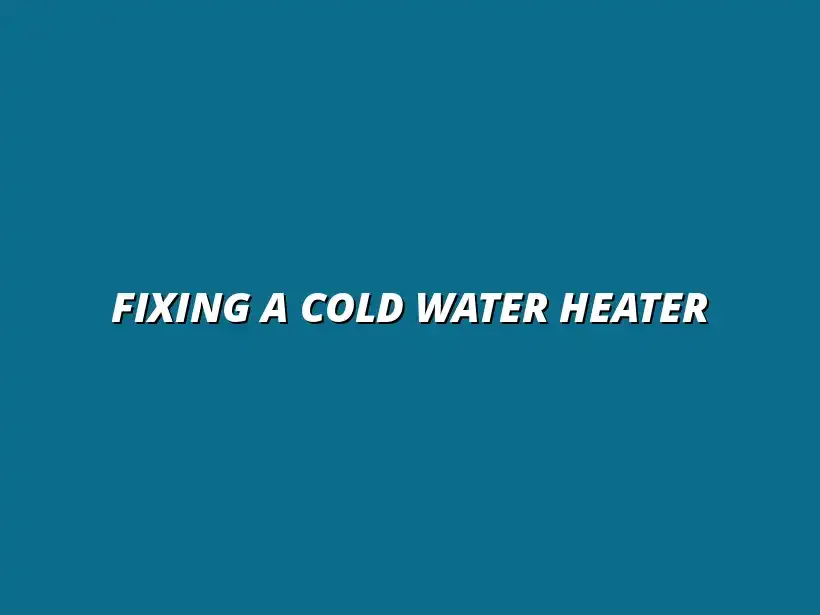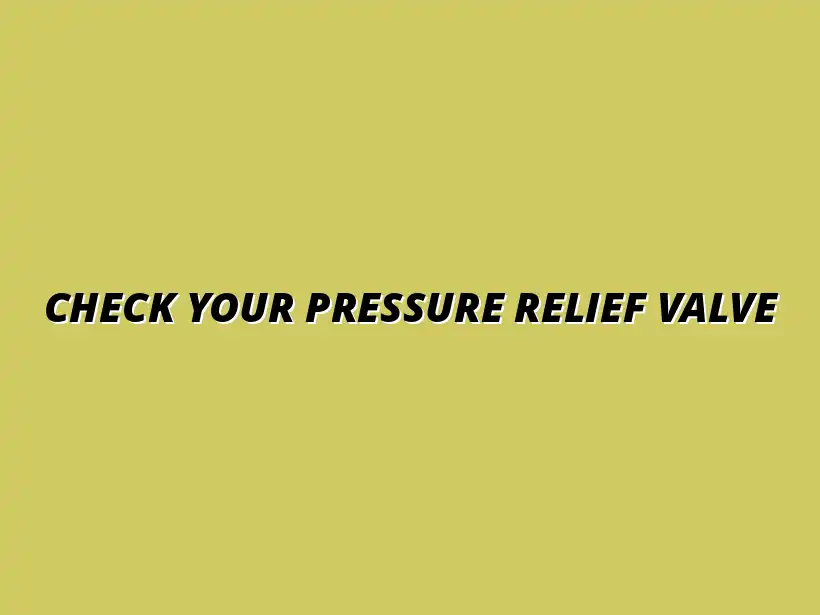
Check Your Pressure Relief Valve
Understanding the Role of Pressure Relief Valves in Safety Systems
Pressure relief valves (PRVs) are critical components in various safety systems, serving a vital purpose in maintaining safe operating conditions. They are designed to automatically release excess pressure from a system, helping to prevent potential failures and catastrophic events. By understanding their role, we can appreciate how important these devices are in both industrial and residential settings. For example, issues with water pressure, a common problem in many homes, can sometimes be linked to problems with pressure relief valves. If you're experiencing low water pressure in your kitchen, you might want to check out this guide on fixing low kitchen water pressure.
The primary function of a pressure relief valve is to protect equipment and processes from overpressure situations. When pressure levels exceed a predetermined limit, the valve opens, allowing fluid or gas to escape. This action reduces pressure within the system, which can be crucial in preventing damage to piping, vessels, and other critical infrastructure.
Defining Pressure Relief Valves and Their Purpose
To grasp the significance of pressure relief valves, it’s essential to define what they are. A PRV is a safety device that regulates or limits the pressure in a system or vessel. They come in various designs and sizes, but all serve the same fundamental purpose: ensuring safety and operational integrity. Understanding how to maintain your water heater efficiently can also contribute to overall system pressure management. Check out these tips to maintain your water heater efficiently.
These valves are often used in conjunction with pressure gauges to monitor the system's pressure continuously. The settings on these devices are typically calibrated based on the specific requirements of the application, making them highly versatile across multiple industries.
- Oil and gas production
- Chemical processing
- Water treatment facilities
- Manufacturing plants
Importance of Pressure Relief Valves in Preventing System Failures
The importance of pressure relief valves cannot be overstated, as they play a crucial role in preventing system failures and potential disasters. When a system experiences a pressure spike, it can lead to equipment failure, leaks, or even explosions. By allowing controlled pressure release, PRVs help maintain safe operational conditions. Low water pressure in your water heater can be a significant issue; learning how to troubleshoot and fix this problem is crucial. See this guide on fixing low water pressure in heaters for more information.
Moreover, regular maintenance and testing of these valves are vital to ensure they function correctly when needed. A malfunctioning valve can lead to severe consequences, including safety hazards for personnel and damage to assets. Therefore, understanding their operation is key to maintaining safety in any system.
Common Applications of Pressure Relief Valves
Pressure relief valves find applications in various industries due to their essential function. Here are some common applications:
- Steam boilers: To prevent overpressure that can cause dangerous explosions.
- Hydraulic systems: To protect hydraulic equipment from high pressure that could lead to failure.
- Natural gas systems: To ensure safe venting of gas to prevent hazardous buildup.
- Refrigeration systems: To avoid excessive pressure that might damage the system.
These examples illustrate just a few ways in which pressure relief valves contribute to safety and reliability across different sectors. Understanding their applications can help us recognize their importance in everyday operations. Addressing water heater leaks promptly is vital for preventing further damage and ensuring home safety. This resource on water heater leak causes and fixes can help.
Identifying Signs of Pressure Relief Valve Malfunction
Recognizing signs of pressure relief valve malfunction is crucial for maintaining system safety. A faulty valve can lead to dangerous situations, making it essential to be vigilant about potential issues. Regular inspections and awareness of symptoms can help prevent catastrophic failures. Understanding how to address low water pressure issues more broadly can be helpful in identifying potential valve problems. This guide on fixing low water pressure easily might be useful.
Some key indicators of a malfunctioning pressure relief valve include unusual pressure readings on gauges, physical damage to the valve, or signs of leakage. Being proactive and identifying these symptoms early can save time and resources while ensuring the safety of operations.
Addressing Common Questions About Pressure Relief Valves
Pressure relief valves (PRVs) are critical components in many systems, and it's natural to have questions about their operation and maintenance. Understanding these questions can help ensure that your safety systems remain effective and reliable. I’m here to clarify some common questions and provide you with practical insights.
By addressing frequently asked questions, we can demystify some aspects of pressure relief valves. This will help you feel more confident in managing and maintaining these vital safety devices. Let’s dive into the details!
Frequently Asked Questions on Pressure Relief Valve Testing
One of the most pressing concerns regarding pressure relief valves is understanding what can cause them to fail. Common causes include:
- Corrosion: Exposure to harsh chemicals can lead to degradation.
- Improper Installation: Incorrect positioning can affect valve performance.
- Wear and Tear: Over time, components can become worn, leading to failure.
- Contamination: Dirt and debris can block the valve, preventing it from functioning smoothly.
Another frequent question is how often these valves should be tested. Regular testing is essential, and the general recommendation is:
- Conduct tests at least once a year.
- Test more frequently if the system undergoes heavy usage.
- After any significant maintenance or repairs, always test the valve.
What are the common causes of pressure relief valve failure?
Addressing the causes of PRV failure is crucial to ensuring system reliability. By identifying these issues early, you can take proactive measures to maintain your pressure relief valve effectively. Remember, a well-maintained valve can save you from serious safety hazards! If you are dealing with drainage issues, installing a French drain might be a solution. Learn more about the process by reading installing a French drain.
How often should pressure relief valves be tested?
Regular testing of your pressure relief valves plays a significant role in system safety. Keeping to a testing schedule helps catch potential failures before they escalate into serious problems. It’s always better to be safe than sorry!
Best Practices for Ensuring Valve Longevity
To extend the life of your pressure relief valve, there are some excellent practices to follow. Incorporating these into your routine will enhance performance and reliability:
- Routine Inspections: Check for signs of wear and damage regularly.
- Correct Installation: Ensure proper alignment during installation to avoid issues.
- Environmental Considerations: Protect from extreme temperatures and conditions.
- Follow Manufacturer Guidelines: Always adhere to the specifications provided by the manufacturer.
Additionally, compliance with industry standards is vital for effective operation. This not only enhances the safety of your systems but also ensures that you are meeting regulatory requirements. Following best practices minimizes risks associated with malfunctioning valves. For plumbing issues in Billesley, Birmingham, consider seeking help from a local plumber. Find out more about plumber in Billesley, Birmingham.
Tips for Extending the Life of Your Pressure Relief Valve
These tips are simple yet effective in promoting the longevity of your pressure relief valves. Implementing them can protect your systems and ensure they operate safely for years to come!
Importance of Compliance with Industry Standards
Adhering to industry standards is not just a recommendation but a necessity. It guarantees that your pressure relief valves function optimally and safely. By being compliant, you not only protect your equipment but also contribute to a safer working environment.
Summarizing Key Takeaways on Pressure Relief Valve Functionality
In summary, understanding and maintaining pressure relief valves is key to ensuring their functionality. Regular checks and a solid maintenance schedule can significantly improve safety and system efficiency. It's essential to prioritize these practices to avoid potential failures.
Proactive maintenance offers numerous benefits, including reduced breakdowns, lower repair costs, and enhanced safety. The more effort you put into maintaining your pressure relief valves, the better off your systems will be!
Reviewing the Importance of Regular Checks
Regular inspections are vital to the integrity of your pressure relief valves. They help catch problems early, preventing unsafe conditions. By investing time in these checks, you’re taking a crucial step towards ensuring safety.
Benefits of Proactive Pressure Relief Valve Maintenance
Proactive maintenance serves several purposes, such as:
- Increased Reliability: Regular checks improve valve performance.
- Cost Efficiency: Preventing issues saves money in the long run.
- Safety Assurance: Regular maintenance ensures compliance and safety.
Concluding Thoughts on Ensuring Safety and Efficiency
In conclusion, addressing questions about pressure relief valves and practicing regular maintenance will go a long way in ensuring both safety and efficiency. I encourage you to take these insights seriously, as they can help protect you and your systems!
Encouraging Readers to Take Action
Now is the time to implement immediate checks and maintenance for your pressure relief valves. Don’t wait for issues to arise; be proactive!
To assist you further, consider looking into available resources for learning more about pressure relief valves. Books, manuals, and online courses can deepen your understanding and help you stay informed. Let's prioritize safety together!
